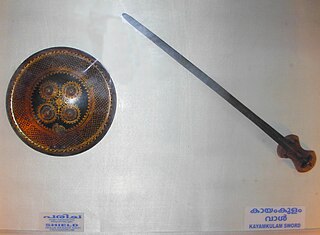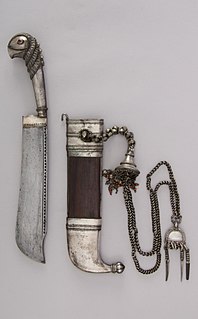 W
WThe firangi (Marathi:फिरंगाना) was an Indian sword type which used blades manufactured in Western Europe, particularly Solingen, and imported by the Portuguese, or made locally in imitation of European blades.
 W
WKayamkulam vaal is a double-edged sword that was used by the rulers and soldiers of Nair aristocracy, in the Kayamkulam princely state of India. An example is on display at the Krishnapuram Palace Museum in Kayamkulam.
 W
WThe khanda is a double-edge straight sword originating from the Indian subcontinent. It is often featured in religious iconography, theatre and art depicting the ancient history of India. It is a common weapon in Indian martial arts. Khanda often appears in Sikh, Jain, Buddhist and Hindu scriptures and art.
 W
WThe pata or patta is a sword, originating from the Indian subcontinent, with a gauntlet integrated as a handguard. Often referred to in its native Marathi as a dandpatta, it is commonly called a gauntlet-sword in English.
 W
WPichangatti is a broad-bladed knife of the Kodavas of Karnataka, India. The characteristic of the pichangatti is its silver hilt with bulbous-shaped pommel in the shape of a parrot's head. The pichangatti features in the traditional male dress of the Kodavas.
 W
WRam-dao are traditional sacrificial swords used in the Hindu ritual sacrifice of animals. The large, curved blade is designed to decapitate a sacrificial animal in a single stroke. Ram-daos are used in a hacking swing and are distinct from both the Chinese Dao and the Naga Dao swords which were traditionally used as slashing weapons. The swords hilt and blade were often adorned with precious stones and metals. The sword was also embellished with religious imagery, symbols, and texts. This type of ritual sword was used widely by cultures in multiple regions including: Assam, Bengal, East India, Nepal, and North India.
 W
WThe talwar, also spelled talwaar and tulwar, is a type of curved sword or sabre from the Indian subcontinent.
 W
WUrumi is a sword with a flexible, whip-like blade, originating in modern-day Kerala in the Indian subcontinent. It is thought to have existed from as early as the Sangam period.